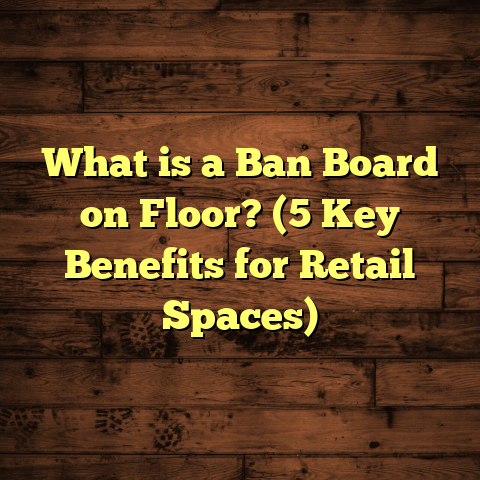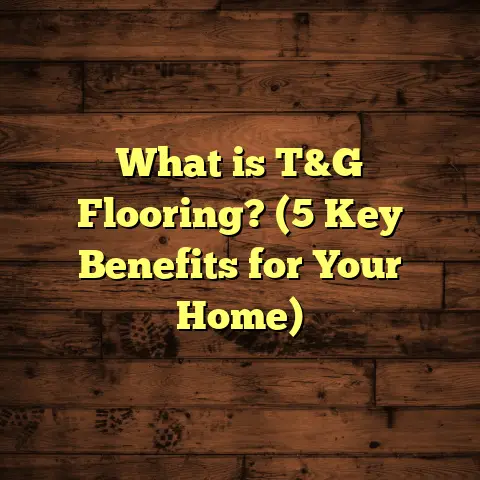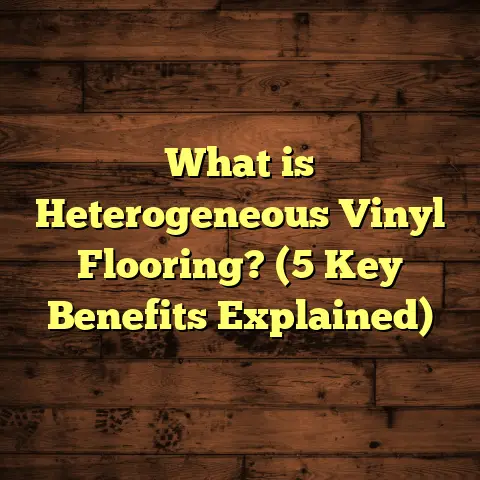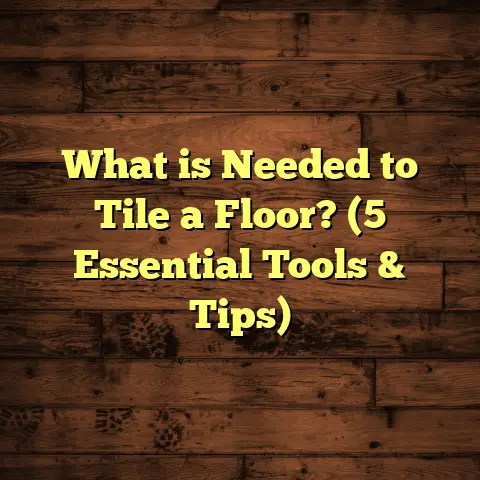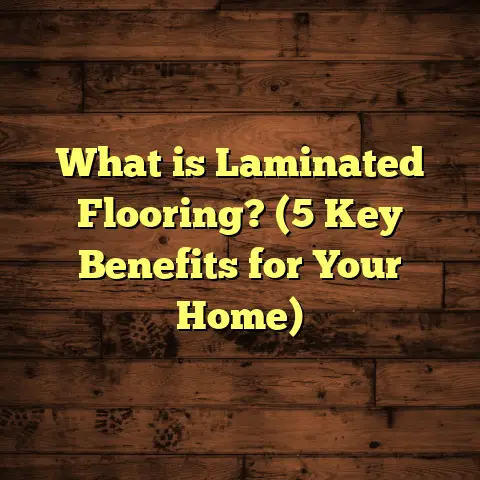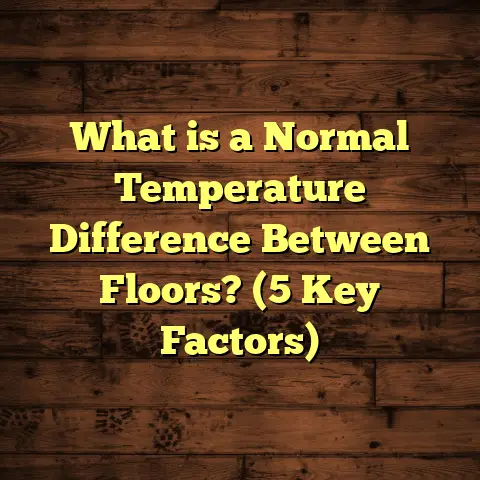What is Vinyl Wood Flooring? (5 Key Benefits and Uses)
When I think about selling a home, one of the first things that pop into my mind is the flooring’s impact on resale value. Flooring is often one of the first details prospective buyers notice when they walk in. Over my years working as a flooring contractor, I’ve seen how the right floors can increase a home’s appeal and market price significantly. People often ask me about vinyl wood flooring—what it is, why it’s popular, and whether it’s a good investment. So, let me take you through everything I know from hands-on experience, detailed research, and plenty of client stories.
What Is Vinyl Wood Flooring?
Vinyl wood flooring is a flooring material designed to look like traditional hardwood but made from synthetic materials. It’s primarily composed of polyvinyl chloride (PVC), which makes it resilient, flexible, and waterproof. The key idea is to give you the aesthetic beauty of wood without some of the drawbacks that real wood can have.
The manufacturing process involves printing ultra-realistic images of wood grain onto vinyl layers. A clear protective wear layer covers this printed surface to keep it from scratching, staining, or fading. Some vinyl wood products add texture through embossing to mimic the feel of natural wood grain underfoot.
Compared to solid hardwood or even engineered wood, vinyl wood flooring is much more affordable and easier to maintain. It comes mostly in two main varieties:
- Luxury Vinyl Plank (LVP): Thicker planks designed to look nearly identical to hardwood floors.
- Vinyl Composite Tile (VCT) or Sheet Vinyl: Usually thinner and less textured but still capable of mimicking wood patterns.
What Makes Vinyl Wood Flooring Different?
You might wonder how vinyl wood flooring compares to other “wood-look” floors like laminate or engineered hardwood.
- Laminate flooring also uses printed wood patterns but has a fiberboard core and a thin wear layer. Laminate isn’t waterproof and can swell if exposed to moisture.
- Engineered hardwood has a thin veneer of real wood over plywood but costs more and can’t handle moisture as well as vinyl.
- Solid hardwood is beautiful and durable but expensive and prone to scratches, dents, and water damage.
Vinyl wood flooring strikes a balance between appearance, durability, maintenance, and cost. It’s waterproof, soft underfoot, and can be installed over various subfloors with less hassle.
How Vinyl Wood Flooring Has Evolved
When I first started in the flooring business more than a decade ago, vinyl floors had a reputation for looking cheap and plastic-like. Early versions were thin sheets with dull colors that didn’t fool anyone into thinking they were wood.
But technology has come a long way since then. Modern LVP flooring uses high-definition printing and embossed textures to create stunningly realistic wood appearances. Some manufacturers even replicate knots, grain patterns, and color variations down to a microscopic level.
This progress has helped vinyl wood flooring shed its old image and become a favorite among homeowners wanting style with low upkeep.
Successes and Challenges: What I’ve Learned Installing Vinyl Wood Floors
Having installed vinyl wood flooring in dozens of homes and commercial spaces, I’ve gathered quite a bit of firsthand knowledge about what works well—and what might trip you up.
Success Stories
One memorable project was for a family with two energetic dogs who’d destroyed every floor they had before. The client wanted something durable yet warm-looking. We chose a luxury vinyl plank that was both waterproof and scratch-resistant.
After two years of heavy pet activity, the floor still looked fantastic. The client told me it was easy to clean up mud tracked inside and that no scratching showed through. They said it saved them money and headaches compared to replacing hardwood every few years.
Another time, I worked on an unfinished basement renovation for a couple who planned on turning it into a playroom and home theater. Basements often have moisture issues that ruin hardwood floors or carpet. We installed waterproof vinyl planks that gave the room a cozy, warm look without worry.
The clients loved how soft it felt underfoot compared to tile or concrete. Plus, it dampened sound nicely during movie nights.
Challenges and Drawbacks
Vinyl wood flooring isn’t flawless though. One common problem I’ve run into is poor subfloor preparation. Because vinyl planks are thinner than hardwood boards, any bump or unevenness in the subfloor shows through on the surface.
I remember a job where we rushed installation over an old plywood subfloor with some warping. Soon after installation, clients noticed dimples and bumps in several areas. We had to pull up the planks and level the subfloor properly before reinstalling.
Another issue involves scratches or punctures from sharp or heavy objects. Although vinyl is more scratch-resistant than hardwood, it’s not indestructible. I’ve seen clients accidentally drag heavy furniture across the floor leaving gouges that needed patching.
Color fading can also occur if vinyl wood floors sit in direct sunlight for long periods without UV protection. Some clients didn’t realize their south-facing windows caused fading near entryways or sunrooms.
Lastly, while vinyl floors are water-resistant, they aren’t completely waterproof if water seeps underneath via gaps or damaged seams. Standing water can cause adhesive failure or mold issues if not cleaned quickly.
5 Key Benefits of Vinyl Wood Flooring
If you’re wondering why so many people choose vinyl wood flooring, these benefits often top the list based on my experience and industry data.
1. Affordable Style That Looks Real
I’ve seen homeowners hesitant to spend thousands on hardwood floors but still wanting that classic wood look. Vinyl offers beautiful designs mimicking oak, maple, walnut—you name it—at a fraction of the price.
Costs for vinyl wood flooring generally range from $2 to $7 per square foot installed, while hardwood often starts around $8-$15 per square foot or more depending on species and finish.
In one project, a client wanted a living room upgrade but had limited budget. We installed vinyl planks resembling natural cherry wood for less than half the cost of solid hardwood. The end result was stylish yet economical.
2. Water Resistance for Peace of Mind
Vinyl’s synthetic composition makes it excellent at resisting water penetration—perfect for kitchens, bathrooms, basements, and laundry rooms where moisture is common.
Real hardwood can warp or buckle when exposed to water; laminate swells quickly; but vinyl planks remain stable even if spills aren’t wiped immediately.
According to recent industry statistics:
- Over 70% of homes with vinyl plank flooring reported no moisture-related damage after five years.
- Vinyl floors outperform hardwood by over 50% in water resistance tests conducted by independent labs.
3. Simple Installation Saves Time and Money
One thing I love about vinyl wood flooring is how easy it is to install compared to traditional hardwood. Many LVP products feature click-lock systems that snap together without glue or nails.
I’ve taught several DIY clients how to install their own floors over weekends with minimal tools—saving them hundreds in labor costs.
Some products come with peel-and-stick backing for even quicker application over smooth subfloors.
4. Low Maintenance Fits Busy Lifestyles
Maintaining hardwood floors can be time-consuming—regular sweeping, refinishing every few years, avoiding harsh cleaners.
Vinyl floors require very little upkeep: mostly sweeping or vacuuming plus occasional damp mopping with mild detergent.
One busy family I worked with said they loved how their vinyl floor stayed beautiful despite kids spilling juice or tracking dirt inside daily.
5. Comfort Underfoot and Noise Reduction
Vinyl flooring tends to be softer than tile or hardwood because it contains layers that cushion each step.
This softness means less foot fatigue when standing long hours in kitchens or playrooms—and reduced noise transmission between floors.
In fact, sound tests on homes with LVP showed an average reduction in impact noise by about 20%, making homes quieter overall.
Where Does Vinyl Wood Flooring Work Best?
If you’re thinking about where vinyl wood makes sense in your home or business, here are some common use cases from my projects:
Kitchens
Kitchen floors need to handle spills, dropped utensils, heavy foot traffic, and occasional dropped pots without damage.
Vinyl’s waterproof nature means it won’t warp like hardwood when water drips near sinks or ovens.
Plus, its easy cleaning routine helps keep kitchens looking fresh despite grease buildup or food messes.
Bathrooms
Bathrooms are full of moisture challenges—from showers to sinks to toilets.
Vinyl wood flooring works great here because it resists mold growth better than carpet or even wood alternatives prone to water damage.
Basements & Laundry Rooms
Basements often have high humidity or occasional flooding risks that destroy traditional floors.
I’ve installed vinyl plank floors in dozens of basements where other options would fail quickly due to moisture intrusion.
Laundry rooms also benefit from its resilience against water spills or detergent leaks.
Rental Properties & Multi-Family Housing
Landlords love vinyl wood flooring because it balances durability with affordability—helping maintain units between tenants without costly repairs.
The scratch-resistant surface holds up well under heavy foot traffic from tenants moving furniture in and out frequently.
Commercial Spaces
Retail shops, offices, salons, and cafes often want an upscale “wood” floor look without high maintenance costs.
Vinyl plank floors provide the right mix of aesthetics and toughness needed for daily use by customers and employees alike.
Personal Stories from My Vinyl Wood Flooring Projects
Let me share a few client stories that show how versatile vinyl wood flooring really is:
The Dog-Loving Family
A couple with two large dogs struggled with scratched hardwood floors before switching to luxury vinyl plank. They told me their biggest relief was not worrying about muddy paws ruining the floor after walks in wet weather.
After two years with no visible scratches or stains, they said the floor looked brand new despite heavy use—a major win considering their lifestyle.
The Basement Transformation
A young couple wanted their unfinished basement converted into a multipurpose family room but worried about moisture damage from underground humidity.
We chose waterproof LVP with soundproof backing that made the space cozy and quiet during movie nights while standing up perfectly against occasional dampness below grade.
They loved how natural the floor looked compared to old concrete or tile alternatives they considered.
The DIY Weekend Warriors
I once helped a pair who wanted to install their own flooring over an old tiled kitchen floor without hiring contractors.
We picked an easy click-lock vinyl plank product with instructions clear enough for beginners. They finished installation in just two days while enjoying their newfound confidence in home improvement skills!
Important Considerations Before You Buy Vinyl Wood Flooring
While I’m a big fan of vinyl wood floors, there are some things you should keep in mind before making your choice:
Subfloor Condition Matters
For best results, your subfloor should be flat, clean, dry, and free of debris. Unevenness will telegraph through thin vinyl planks as bumps or ridges.
Sometimes this means extra prep work like leveling compounds before installation—which adds time but ensures a smooth finish.
Quality Varies by Brand
Not all vinyl products are created equal. Higher-end brands offer thicker wear layers (20 mils or more), better embossing textures, and warranties up to 20 years.
Cheaper products may look decent initially but wear out faster or fade under UV exposure.
Ask your supplier about wear layer thickness:
- 12 mil = residential moderate traffic
- 20 mil+ = commercial or heavy residential traffic
Temperature Sensitivity
Vinyl expands slightly with temperature changes. Rooms with large fluctuations may require expansion gaps around edges during installation to prevent buckling.
Environmental Impact
Vinyl production involves PVC plastics which aren’t biodegradable. However, some manufacturers now offer recycled content options or programs for recycling old planks responsibly.
If sustainability is important to you, research brands offering greener products or certifications like FloorScore® for indoor air quality.
Data & Research Insights on Vinyl Wood Flooring Performance
I’ve reviewed several industry studies that back up what I see on the ground:
- Durability: Tests show luxury vinyl planks hold up well against scratching compared to laminate or engineered hardwood.
- Water Resistance: Vinyl floors maintain dimensional stability even after 24 hours submerged in water.
- Installation Speed: Professional installers report up to 30% faster installation times with click-lock LVP versus traditional hardwood.
- Customer Satisfaction: Surveys indicate over 85% of homeowners installing vinyl planks are satisfied with appearance after one year.
- Resale Impact: Homes featuring modern vinyl plank flooring sell at prices comparable to those with mid-level hardwood floors in similar neighborhoods according to multiple real estate market analyses conducted between 2020–2023.
Frequently Asked Questions About Vinyl Wood Flooring
Here are some common questions I hear from clients:
Q: Can I install vinyl wood flooring myself?
A: Yes! Many LVP products are designed for DIY installation with click-together planks or peel-and-stick backing. Just ensure your subfloor is properly prepared first.
Q: How long does vinyl wood flooring last?
A: With proper care, luxury vinyl plank floors typically last 10–20 years depending on wear layer thickness and traffic levels.
Q: Is vinyl flooring safe for pets?
A: Absolutely! Vinyl is scratch-resistant and waterproof—ideal for pets who might track dirt or have accidents indoors.
Q: Can I install vinyl over existing flooring?
A: Often yes—as long as existing floor is flat and stable (e.g., tile or hardwood). Avoid installing over carpet unless removed first.
Q: Is vinyl flooring eco-friendly?
A: Vinyl isn’t biodegradable but newer products may contain recycled materials and have certifications ensuring low VOC emissions for indoor air quality.
Final Thoughts From My Experience
If you’re looking for affordable beauty combined with durability and low upkeep—vinyl wood flooring deserves serious consideration. It has evolved tremendously over the last decade from basic plastic sheets into realistic planks that can transform kitchens, basements, rentals, offices—almost anywhere you want a warm wood look without the fuss of real hardwood.
Whenever I consult clients on flooring options today, I always suggest they explore luxury vinyl plank first if budget constraints or moisture concerns exist. It’s saved many homeowners money while giving them exactly the aesthetic they want—and that’s what makes me confident recommending it again and again.
So what do you think? Could vinyl wood flooring work for your home? If you want advice tailored to your specific space or tips on installation best practices, just let me know—I’m happy to help!
